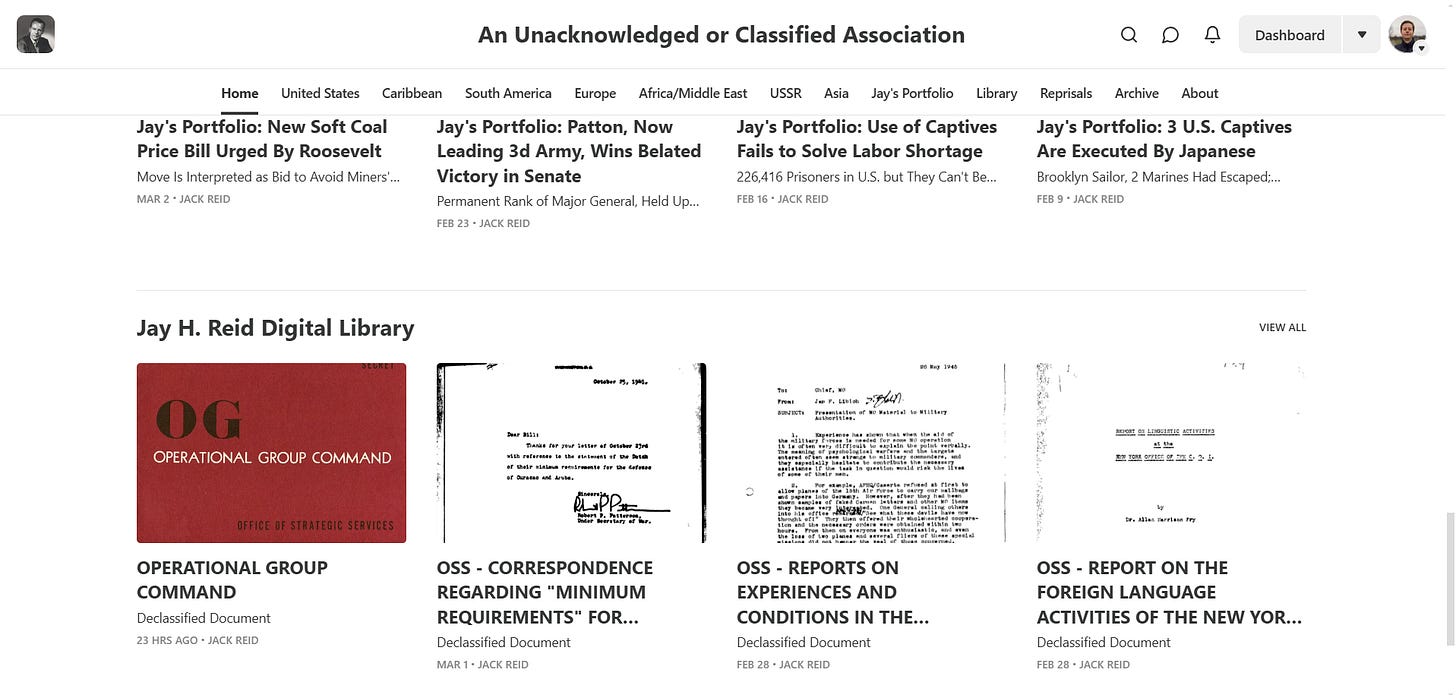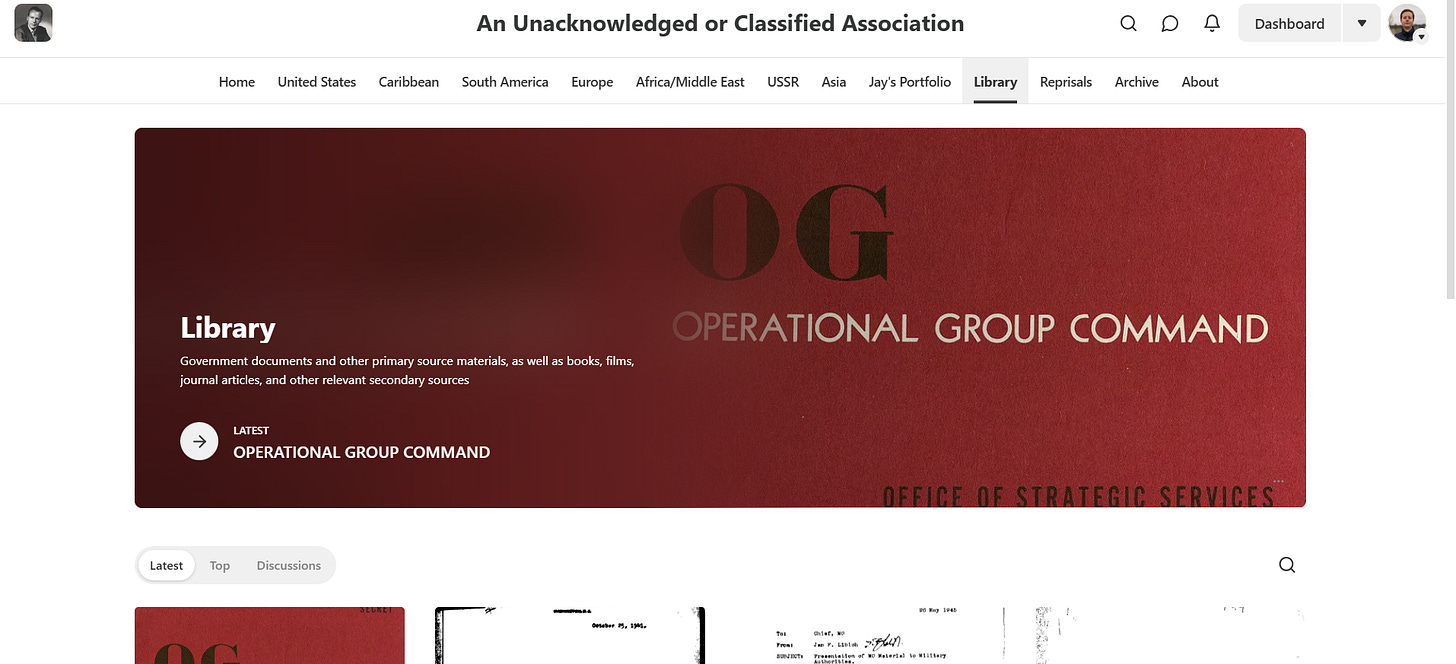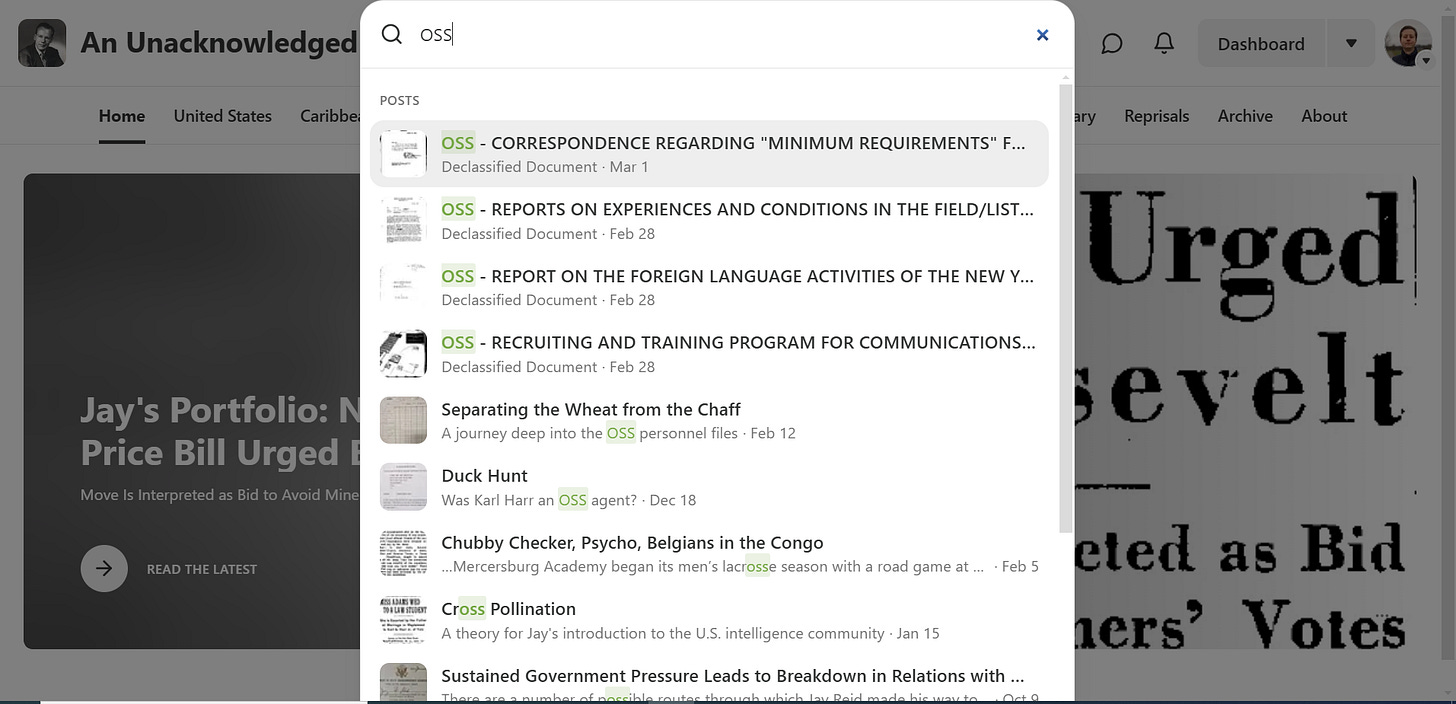Introducing: The Jay H. Reid Digital Library
The next phase of the Jay H. Reid Project is officially underway
Keen observers will note that this newsletter, An Unacknowledged or Classified Association, lives on a website for something called the Jay H. Reid Project.
Today I am unveiling the second phase of the project, the Jay H. Reid Digital Library.
The library is where you will be able to access copies of all primary source materials that are, or may in the future be, relevant to this investigation. The collection will also house many secondary source materials, such as newspaper and academic journal articles. In addition, I will include information about films and books that touch on topics surrounding the investigation.
To date I have uploaded nearly 400 pages of primary source documents out of the more than 10,000 that I have identified and begun collecting.
Relevant secondary source materials currently comprise an additional few thousand pages that will eventually all be available in the library. And again, these numbers represent just what I have identified and/or already collected.
I would not be surprised to see the collection eventually top 100,000 pages.
Purpose
There was a time when I was not sure I would be able to find much information on the strange case of Jay Reid and the CIA.
That time has passed. Now, the biggest challenge is figuring out how to process and make sense of all the available information.
Think about a traditional hard drive, or even a cloud storage site. Each file has a name, but that’s pretty much it. To know what information a document contains, one must open and read it. Notes have to be kept separately.
The Jay H. Reid Digital Library solves these issues. In addition to a PDF attachment containing the actual file and complete citation information, I am using large language models to evaluate each document and produce a summary and list of names mentioned.
And, most importantly, Substack has a great search function. As I work to connect the dots, I will be able to search for the name of a person or place, pull up the relevant documents, review the summaries, then spend time reviewing only those materials that appear relevant.
This setup will enable me to process a large quantity of primary source data in a comparatively short amount of time.
As readers know by now, intelligence cases are extremely complex. One does not read a document so much as meditate over it: read, think, take notes, think, re-read, cross reference, re-read again, etc.
Overall, I expect the library to help improve the rate at which I am able to make connections between people, places, and initiatives.
And, of course, I will continue to detail my findings in articles posted each Wednesday.
How to access the library
The extent to which readers will interact directly with the library is entirely up to them. Library entries will be posted to the website, but not emailed.
To access the library, navigate to the website. Once there, you have two options:
Scroll down to the bottom of the home page, where the most recently added materials are listed.
Click on the Library menu item at the top of the screen for access to all library materials.
To run a site-wide search, click on the magnifying glass and type in the term(s) for which you want to search. Almost instantly, all articles I’ve written (leading caps) and library materials (all caps) will be displayed.
Whenever I cite a source that is in the library, I will provide a link in the article to that source’s page in the library.
For example, this link will take you to the library entry for an 18-page OSS document from 1942 that outlines the recruitment and training programs for communications personnel. The page includes a detailed summary that begins:
The declassified government documents, approved for release on September 9, 2013, under the CIA reference CIA-RDP13X00001R000100110005-7, detail the operations and structure of the Communications Branch of the Office of Strategic Services (OSS), a wartime intelligence agency of the United States during World War II. Below is a brief summary of the key points from the legible text:
1. **Purpose and Scope**: The Communications Branch was responsible for planning, organizing, and operating all OSS communications, excluding telephone and courier services. It supported the OSS’s specialized operations by providing secure and effective communication systems, requiring special equipment and trained personnel.
2. **Training and Recruitment**: The Branch oversaw a detailed training program at designated areas, such as "Area C" and "Area M" in the Midwest. Recruits were trained as technicians, operators, or operator-technicians for field, base station, or mobile unit roles. Training included a minimum of 60 hours of practice in simulated conditions (e.g., "Base Station Watch") and long-range communication exercises. Specialized Direction Finding (DF) personnel and field station operators received additional field training, including covert operations up to 1,000 miles from base stations.
3. **Equipment and Logistics**: The Branch shipped 60 tons of equipment monthly, managed by the Supply, Shipping, and Warehousing Division. This division procured standard military and specialized equipment, maintained three warehouses, and handled clerical tasks like inventory and shipping schedules, often in coordination with Army and Navy supply services.
This document is included in the collection because of the possibility that Jay’s cousin, Karl Harr, served in the OSS. Other OSS documents may seem further afield, but could provide insights about the OSS activities of Karl’s colleagues at the law firm Sullivan & Cromwell, which could shed more light on Karl’s situation.
Ultimately, this line of inquiry descends from my hypothesis that Jay attended Karl’s wedding to Patricia Adams in October 1947, and there he met people connected to the OSS/CIA.
So, as the library’s contents increase, I encourage you to scan through it periodically. Interacting with primary source documents is a surefire way to improve your understanding of both Jay Reid’s case, and the broader conduct of intelligence operations.
Finally, I want to make explicit the fact that, unlike your local public library, there is no checking in or checking out materials. Feel free to download and share any document that piques your fancy.




